内分泌与代谢疾病
- 格式:doc
- 大小:225.50 KB
- 文档页数:18
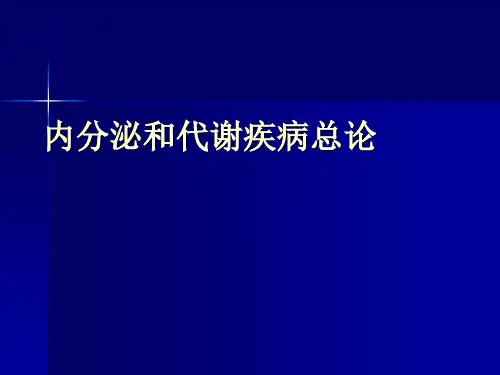
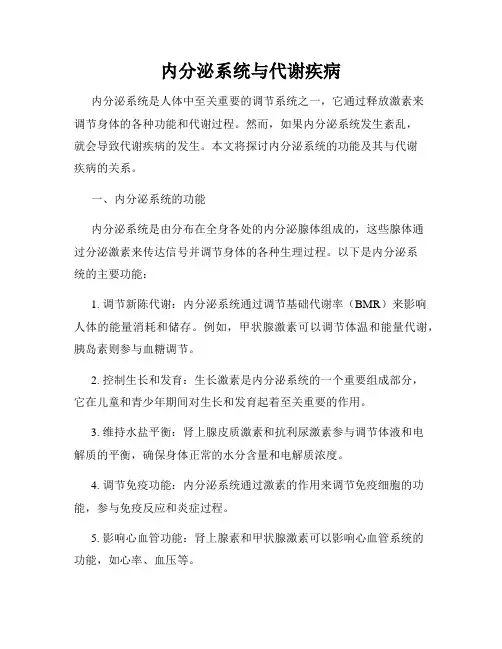


内分泌及代谢疾病概述与常见症状常见的内分泌及代谢疾病包括:1.甲状腺疾病:甲状腺功能亢进症和甲状腺功能减退症是最常见的甲状腺疾病。
甲状腺功能亢进症会导致心跳加快、代谢率增高、体重减轻、焦虑、多汗等症状;而甲状腺功能减退症会导致疲倦、体重增加、便秘、心率缓慢等症状。
2.糖尿病:糖尿病是由于胰岛素分泌不足或细胞对胰岛素的反应降低引起的高血糖症状。
常见症状包括多尿、多食、多渴、体重减轻。
严重的糖尿病还可能引发神经病变、眼病、肾病等并发症。
3.垂体疾病:垂体功能亢进或减退引起的疾病如垂体腺瘤、垂体功能减退症等。
垂体瘤可能导致头痛、视力改变、性激素失调等症状;而垂体功能减退症会导致疲劳、性功能减退、体重增加等症状。
4.骨质疏松症:由于钙负平衡和骨骼组织破坏引起的骨骼疾病。
常见症状包括骨折、背痛、身高减少等。
5.多囊卵巢综合征(PCOS):PCOS是由于卵巢产生过多的雄激素和不正常的卵泡发育引起的女性疾病。
常见症状包括月经不规律、多毛、皮肤痤疮等。
6.甲状旁腺疾病:甲状旁腺功能亢进或减退引起的疾病如甲状旁腺功能亢进症和甲状旁腺功能减退症。
功能亢进会导致高血钙症状如疲劳、骨折等;而功能减退会导致低血钙症状如肌肉痉挛、抽搐等。
上述疾病中的症状可能有重叠,因为不同的内分泌腺体相互影响,异常一个腺体的功能可能对其他腺体造成负面影响。
这些症状还可能受到年龄、性别、个体差异等因素的影响。
确诊这些内分泌及代谢疾病需要进行详细的医学史询问、体格检查和相关实验室检查。
一旦确诊,治疗常常包括药物治疗、手术、放射治疗等手段。
同时,健康的生活方式如饮食控制、体育锻炼和保持良好的心理状态也对预防和治疗这些疾病有益。
总之,内分泌及代谢疾病是一类由于内分泌系统异常功能引起的疾病,常见症状包括代谢紊乱、体重变化、性功能障碍等。
及早发现、正确诊断和及时治疗能够有效控制病情,提高生活质量。
因此,对于可能存在内分泌及代谢疾病的人群应及时就医,并遵循医生的治疗建议。
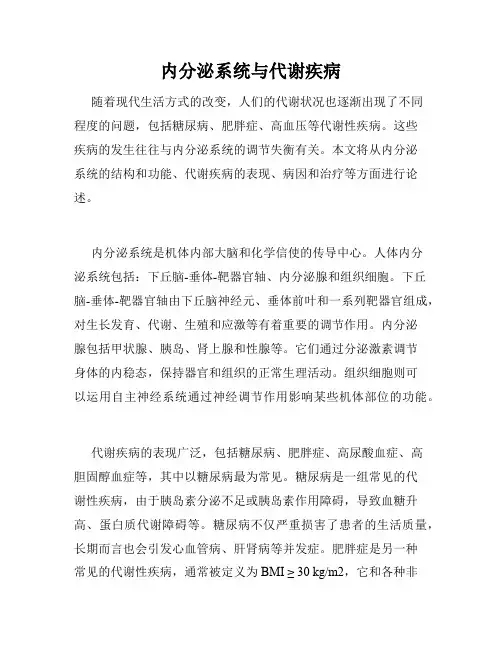
内分泌系统与代谢疾病随着现代生活方式的改变,人们的代谢状况也逐渐出现了不同程度的问题,包括糖尿病、肥胖症、高血压等代谢性疾病。
这些疾病的发生往往与内分泌系统的调节失衡有关。
本文将从内分泌系统的结构和功能、代谢疾病的表现、病因和治疗等方面进行论述。
内分泌系统是机体内部大脑和化学信使的传导中心。
人体内分泌系统包括:下丘脑-垂体-靶器官轴、内分泌腺和组织细胞。
下丘脑-垂体-靶器官轴由下丘脑神经元、垂体前叶和一系列靶器官组成,对生长发育、代谢、生殖和应激等有着重要的调节作用。
内分泌腺包括甲状腺、胰岛、肾上腺和性腺等。
它们通过分泌激素调节身体的内稳态,保持器官和组织的正常生理活动。
组织细胞则可以运用自主神经系统通过神经调节作用影响某些机体部位的功能。
代谢疾病的表现广泛,包括糖尿病、肥胖症、高尿酸血症、高胆固醇血症等,其中以糖尿病最为常见。
糖尿病是一组常见的代谢性疾病,由于胰岛素分泌不足或胰岛素作用障碍,导致血糖升高、蛋白质代谢障碍等。
糖尿病不仅严重损害了患者的生活质量,长期而言也会引发心血管病、肝肾病等并发症。
肥胖症是另一种常见的代谢性疾病,通常被定义为BMI ≥ 30 kg/m2,它和各种非传染性疾病的风险异质性、动脉粥样硬化、内脏脂肪的积蓄等疾病密切相关。
代谢疾病的病因复杂,多种因素如遗传、环境、生活习惯等互相影响。
作为一种常见的代谢性疾病,糖尿病的发病存在诸多风险因素,例如肥胖、家族病史、日常饮食过量等。
研究表明肥胖症是糖尿病无疑的重要风险因素,因为它会导致胰岛素抵抗,从而引发糖尿病的发生。
此外,现代生活方式中的环境和社会因素也在加重人们代谢性疾病的病因,例如持续的压力、过度食物摄入、睡眠不足等。
治疗代谢疾病的方法包括生活方式干预和药物治疗等。
生活方式干预主要包括控制食物摄入、定期进行体育运动以及避免饮酒等不良习惯。
药物治疗方面,胰岛素类药物、口服降糖药、胰岛素增敏剂等被广泛应用于糖尿病的治疗;而针对肥胖症的治疗方法则包括饮食治疗、运动、药物治疗以及手术治疗等多种方法。

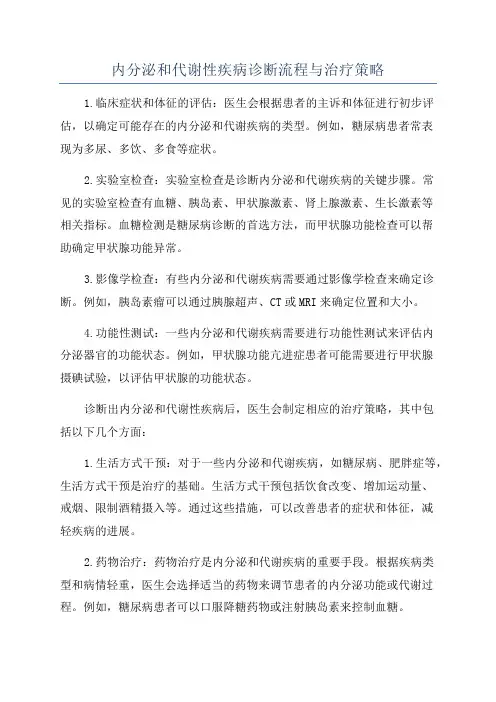
内分泌和代谢性疾病诊断流程与治疗策略1.临床症状和体征的评估:医生会根据患者的主诉和体征进行初步评估,以确定可能存在的内分泌和代谢疾病的类型。
例如,糖尿病患者常表现为多尿、多饮、多食等症状。
2.实验室检查:实验室检查是诊断内分泌和代谢疾病的关键步骤。
常见的实验室检查有血糖、胰岛素、甲状腺激素、肾上腺激素、生长激素等相关指标。
血糖检测是糖尿病诊断的首选方法,而甲状腺功能检查可以帮助确定甲状腺功能异常。
3.影像学检查:有些内分泌和代谢疾病需要通过影像学检查来确定诊断。
例如,胰岛素瘤可以通过胰腺超声、CT或MRI来确定位置和大小。
4.功能性测试:一些内分泌和代谢疾病需要进行功能性测试来评估内分泌器官的功能状态。
例如,甲状腺功能亢进症患者可能需要进行甲状腺摄碘试验,以评估甲状腺的功能状态。
诊断出内分泌和代谢性疾病后,医生会制定相应的治疗策略,其中包括以下几个方面:1.生活方式干预:对于一些内分泌和代谢疾病,如糖尿病、肥胖症等,生活方式干预是治疗的基础。
生活方式干预包括饮食改变、增加运动量、戒烟、限制酒精摄入等。
通过这些措施,可以改善患者的症状和体征,减轻疾病的进展。
2.药物治疗:药物治疗是内分泌和代谢疾病的重要手段。
根据疾病类型和病情轻重,医生会选择适当的药物来调节患者的内分泌功能或代谢过程。
例如,糖尿病患者可以口服降糖药物或注射胰岛素来控制血糖。
3.手术治疗:对于一些内分泌和代谢疾病,如甲状腺结节、肾上腺肿瘤等,手术治疗可能是必需的。
手术可以通过切除异常器官或肿瘤,恢复正常的内分泌功能。
4.其他治疗:除了上述常规治疗外,对于一些特殊疾病,可能需要其他治疗策略。
例如,对于生长激素缺乏症患者,可以使用合成生长激素来治疗。
总之,内分泌和代谢性疾病的诊断和治疗需要综合考虑患者的临床症状和体征、实验室检查结果以及影像学检查等,以确定准确的诊断,并制定个体化的治疗策略。
早期诊断和及时治疗是控制这类疾病进展和减轻患者症状的关键。
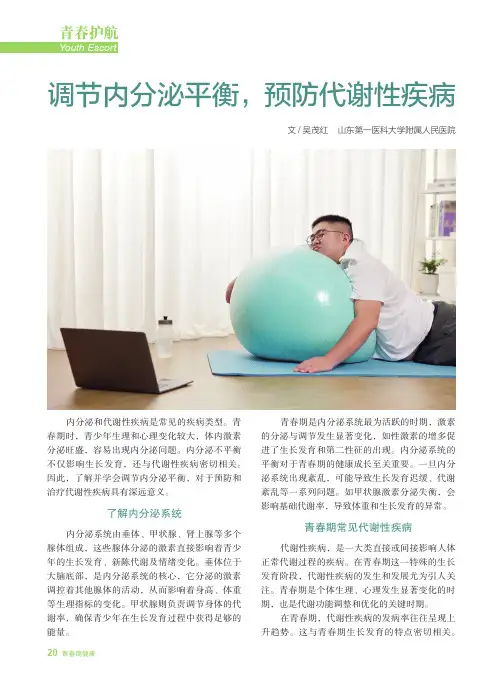
内分泌和代谢性疾病是常见的疾病类型。
青春期时,青少年生理和心理变化较大,体内激素分泌旺盛,容易出现内分泌问题。
内分泌不平衡不仅影响生长发育,还与代谢性疾病密切相关。
因此,了解并学会调节内分泌平衡,对于预防和治疗代谢性疾病具有深远意义。
了解内分泌系统内分泌系统由垂体、甲状腺、肾上腺等多个腺体组成,这些腺体分泌的激素直接影响着青少年的生长发育、新陈代谢及情绪变化。
垂体位于大脑底部,是内分泌系统的核心,它分泌的激素调控着其他腺体的活动,从而影响着身高、体重等生理指标的变化。
甲状腺则负责调节身体的代谢率,确保青少年在生长发育过程中获得足够的能量。
青春期是内分泌系统最为活跃的时期,激素的分泌与调节发生显著变化,如性激素的增多促进了生长发育和第二性征的出现。
内分泌系统的平衡对于青春期的健康成长至关重要。
一旦内分泌系统出现紊乱,可能导致生长发育迟缓、代谢紊乱等一系列问题。
如甲状腺激素分泌失衡,会影响基础代谢率,导致体重和生长发育的异常。
青春期常见代谢性疾病代谢性疾病,是一大类直接或间接影响人体正常代谢过程的疾病。
在青春期这一特殊的生长发育阶段,代谢性疾病的发生和发展尤为引人关注。
青春期是个体生理、心理发生显著变化的时期,也是代谢功能调整和优化的关键时期。
在青春期,代谢性疾病的发病率往往呈现上升趋势。
这与青春期生长发育的特点密切相关。
青春期健康20一方面,青春期人体的能量需求增加,饮食结构和习惯的变化可能导致营养摄入不均衡,从而增加代谢性疾病的患病风险。
另一方面,青春期激素水平变化也可能对代谢功能产生影响,如性激素的分泌增加可能导致胰岛素抵抗和脂肪堆积等问题。
常见的代谢性疾病如糖尿病、肥胖症和心血管疾病不仅影响个体的生长发育,还可能对其心理健康和社会适应能力产生负面影响。
因此,对于青春期的青少年来说,调节内分泌平衡是预防和治疗代谢性疾病的重要手段之一。
心血管疾病和高血压是青春期少年面临的严重代谢性疾病。
心血管疾病,如冠心病和心肌梗死,可能因不良的生活习惯和饮食习惯而提前发生。
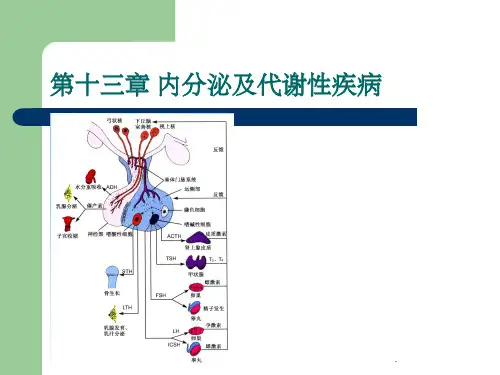
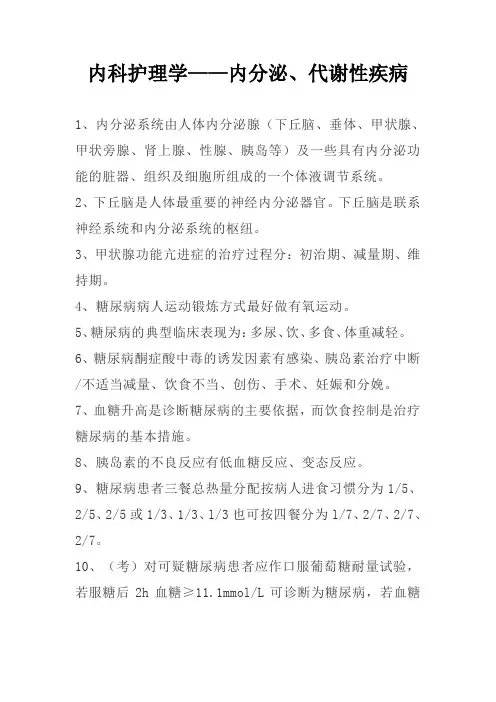
内科护理学——内分泌、代谢性疾病1、内分泌系统由人体内分泌腺(下丘脑、垂体、甲状腺、甲状旁腺、肾上腺、性腺、胰岛等)及一些具有内分泌功能的脏器、组织及细胞所组成的一个体液调节系统。
2、下丘脑是人体最重要的神经内分泌器官。
下丘脑是联系神经系统和内分泌系统的枢纽。
3、甲状腺功能亢进症的治疗过程分:初治期、减量期、维持期。
4、糖尿病病人运动锻炼方式最好做有氧运动。
5、糖尿病的典型临床表现为:多尿、饮、多食、体重减轻。
6、糖尿病酮症酸中毒的诱发因素有感染、胰岛素治疗中断/不适当减量、饮食不当、创伤、手术、妊娠和分娩。
7、血糖升高是诊断糖尿病的主要依据,而饮食控制是治疗糖尿病的基本措施。
8、胰岛素的不良反应有低血糖反应、变态反应。
9、糖尿病患者三餐总热量分配按病人进食习惯分为1/5、2/5、2/5或1/3、1/3、l/3也可按四餐分为l/7、2/7、2/7、2/7。
10、(考)对可疑糖尿病患者应作口服葡萄糖耐量试验,若服糖后2h血糖≥11.1mmol/L可诊断为糖尿病,若血糖<7.8mmol/L,服糖后2h血糖于7.8-11.1mmol/L之间为糖耐量异常。
11、内分泌系统的主要功能是在神经支配和物质代谢反馈调节的基础上,调节人体的生长、发育、生殖、代谢、运动、病态、衰老等生命现象,维持人体内环境的相对稳定。
12、常用的抗甲状腺药物分为硫脲类咪唑类两类,其都是阻断甲状腺素的合成。
13、甲亢病人应每日饮水2000-3000ml,以补充出汗、腹泻、呼吸加快等所丢失的水份。
14、糖尿病病人每日饮食中食用纤维含量>40g为宜。
15、弥漫性毒性甲状腺肿的临床表现甲状腺毒症、弥漫性甲状腺肿、眼征和胫前粘液性水肿。
16、甲状腺危象主要诱因有感染、手术、放射性碘治疗、严重精神创伤、严重药物反应、过量服用、TH制剂、严重躯体疾病等。
17、甲亢的治疗包括抗甲状腺药物治疗、放射性碘治疗、手术治疗三种。
18、甲亢的护理在饮食方面要给予高热量、高蛋白、高维生素饮食,提供足够热量和营养以补充消耗。

第九章内分泌系统疾病及代谢疾病甲状腺功能亢进【病因】1、遗传易感性;2、诱因:感染、精神创伤等。
【临床表现】1、基本特点:女性多见,男女之比为1: 46;各年龄组均可发病,以20至40岁多见;多数起病缓慢,少数可在精神创伤、感染等应激后急性起病。
2、一般表现:患者常有疲乏无力、怕热多汗、皮肤温暖潮湿、体重减轻、低热等。
3、精神、神经系统表现:神经过敏、多言好动、紧张忧虑、焦躁易怒、失眠不安、思想不集中、记忆力减退,偶有寡言抑郁、神情淡漠等;4、心血管系统表现:可有心悸、胸闷、气短,体征可有心动过速等;5、眼球向前突出:眼白增多、甲状腺增大;6、其他表现:手、眼睑、舌震颤,食欲亢进,月经减少或闭经等。
【治疗用药】(抗甲状腺药物)1、硫脲类:甲硫氧嘧啶、丙硫氧嘧啶等;2、咪唑类:甲巯咪唑类(他巴唑)、卡比马唑(甲亢平)等;3、其他:甲亢灵片、B受体阻滞剂(心得安、阿替洛尔等)。
【手术治疗】甲状腺次全切除手术也是甲亢的有效治疗方法。
手术适应证为:(1)甲状腺明显肿大(III度以上),血管杂音明显,内科治疗后甲状腺无明显缩小。
(2)结节性甲状腺肿或毒性腺瘤。
(3)内科治疗效果不理想,多次复发。
(4)长期药物治疗有困难或难以坚持者。
病人必须经抗甲状腺药物治疗后,甲状腺功能(主要为TT4、FT4、TT3及FT3)恢复到正常,再经过充分的术前准备,包括服用卢戈氏液3次/d,每次10滴,2〜3周后才能进行手术。
抗甲状腺药物可服到术前5〜7 天停用。
注:“复方碘口服液”仅用于甲状腺手术前准备和甲状腺危象。
“甲状腺素片”用于甲状腺功能减低。
【饮食注意】1、禁食乳制品至少3个月.禁用咖啡、茶、尼古丁和刺激性饮料食品.2、甲亢患者可常吃花生、苏子等具有抑制甲状腺素合成的食物.火盛者可用西瓜、菜豆、芹菜、金针菜等凉性食物.阴虚者可用有滋阴功能的食物,如木耳、桑相、甲鱼、鸭等.脾虚者可用健脾止泻的食物,如山药、芡实、苹果、大枣、芥菜等.3、多吃含钾高的食物,也应食用富含钙和磷的食物.4、患者除要忌用含碘高的食物外,饮食中还要忌温热、辛燥的食物,如辣椒、桂皮、生姜、羊肉等.还有浓茶、咖啡等.5、限制食物纤维,应少吃糠麸、卷心菜、苹果、胡萝卜等含食物纤维多的食物.甲亢患者常伴有排便次数增多或腹泻的症状糖尿病糖尿病是由遗传和环境因素相互作用而引起的常见病,临床以高血糖为主要标志,常见症状有多饮、多尿、多食以及消瘦等。
内分泌系统与代谢疾病的关系分析内分泌系统是人体中调节生长、发育、代谢、生殖等功能的关键系统,它通过分泌激素在全身产生协调作用。
代谢疾病是指人体代谢出现异常,导致身体机能发生障碍所引起的一类疾病,包括糖尿病、肥胖症、高血压等。
内分泌系统与代谢疾病之间存在着密切的关系,本文将基于这一关系展开分析。
一、内分泌系统与代谢人体中的内分泌器官包括了十多种,其中最重要的有下丘脑-垂体-肾上腺、甲状腺、胰腺、卵巢和睾丸等。
这些内分泌器官的重要作用是产生不同类型的激素,这些激素调节人体内的不同器官和系统,维持人体内部环境的均衡。
其中,胰岛素是最为常见的一种代谢激素,它通过调节血糖水平的变化来控制代谢过程。
代谢是指人体内各种物质在代谢过程中的相互转换和能量的消耗。
与代谢相关的物质主要包括葡萄糖、脂肪、氨基酸和核酸等,同时代谢与营养物质的摄取、利用和排泄等相关。
内分泌系统对代谢的调节作用是通过分泌不同类型的激素进行的。
二、内分泌系统与糖尿病糖尿病是一种常见的代谢疾病,它的主要特点是体内胰岛素的分泌不足或胰岛素抵抗性增加,从而导致血糖升高。
糖尿病患者的代谢功能严重受损,严重影响生活质量和健康。
糖尿病的治疗首要的是通过控制饮食和锻炼来维持血糖;其次是通过药物治疗来促进胰岛素的分泌或改善胰岛素的抵抗性。
内分泌系统与糖尿病之间的关系主要是通过胰腺和甲状腺的激素分泌来实现的。
胰岛素的分泌与甲状腺素有关,胰岛素的分泌受到甲状腺疾病的影响。
此外,胰高血糖素和生长激素等激素也能影响糖尿病的发病率。
因此,内分泌系统的稳定对糖尿病的预防和治疗是至关重要的。
三、内分泌系统与肥胖症肥胖症是指体重超标引起的一种代谢疾病,它的发病率也在不断增高。
肥胖症常伴随着高血压,高胆固醇血症和心脏疾病等多种病症,给患者带来了很多的身体和心理负担。
内分泌系统对体重的控制是非常复杂的,其中胰岛素和瘦素是最为重要的两种代谢激素。
胰岛素可以促进能量吸收,而为维持身体健康,必须有一定量的胰岛素被人体吸收;瘦素可以抑制食欲,而其分泌量低时会导致身体大量存储脂肪。
内分泌系统失调与代谢疾病发生的关系怎样才算是内分泌系统失调,代谢疾病又是什么呢?内分泌系统是一个复杂的物质调节系统,由几种内分泌腺体组成,包括甲状腺、垂体、肾上腺、卵巢和睾丸等,这些腺体都会分泌出一种或多种内分泌激素,在人体内进行传递,调控各个器官组织的生长、代谢、分泌、运动等,维持身体内的内环境恒定。
当这些腺体分泌激素过多或过少时,人体就会出现内分泌紊乱的状况,甚至会导致代谢疾病的发生。
代谢疾病是指人体内的某些化学反应发生变化,导致机体代谢异常的一类疾病。
最常见的代谢疾病包括糖尿病、肥胖症、甲状腺功能减退症等。
这些疾病的共同点在于,一旦发生,会极大地影响人体的健康,甚至缩短寿命。
内分泌系统失调与代谢疾病发生的关系有哪些?1. 糖尿病糖尿病是一种常见的代谢疾病,它与内分泌系统失调之间存在着密切关系,其中最主要的因素是胰岛素分泌异常。
胰岛素是由胰腺分泌的一种激素,它可以促进人体细胞对葡萄糖的吸收和利用,从而降低血糖浓度。
当胰岛素分泌不足或细胞对胰岛素反应下降时,血糖浓度就会持续升高,最终导致糖尿病的发生。
2. 肥胖症肥胖症也是一种常见的代谢疾病,它与机体内的内分泌激素分泌紊乱密切相关。
最常见的例子就是胰岛素,由于胰岛素分泌不足或细胞对胰岛素反应下降,机体内的葡萄糖利用率会降低,导致葡萄糖残留在血液中,同时,这些未被利用的能量会被存储为脂肪,从而引起肥胖症的发生。
3. 甲状腺功能减退症甲状腺功能减退症是一种甲状腺激素分泌不足的疾病,由于甲状腺激素是一种能促进细胞代谢的激素,当它分泌不足时,整个身体的代谢水平就会下降,引起各种代谢反应的减缓,最终出现甲状腺功能减退症的症状。
总的来说,内分泌系统失调与代谢疾病的发生之间存在着非常密切的联系。
我们平时需要通过科学地饮食、适当运动来保持身体的健康,从而降低这些疾病的发生率。
注重调节情绪、规律生活、防止过度疲劳等都是促进个人健康的好方法。
同时,我们还应该积极地进行预防、早期诊断和及时治疗,为自己的健康保驾护航。
内分泌失调与代谢性疾病的关系在我们的日常生活中,常常会听到“内分泌失调”这个词。
它似乎与许多身体的不适和健康问题有关,而代谢性疾病也是一类让人们颇为关注的健康隐患。
那么,内分泌失调与代谢性疾病之间究竟有着怎样千丝万缕的联系呢?首先,让我们来了解一下什么是内分泌失调。
内分泌系统是由一系列内分泌腺和分布在全身的内分泌细胞组成的一个复杂的信息传递系统。
这些内分泌腺包括垂体、甲状腺、胰岛、肾上腺、性腺等等,它们分泌的激素直接进入血液循环,对身体的生长、发育、代谢、生殖等生理过程起着重要的调节作用。
当这个系统的平衡被打破,激素分泌过多或过少,就会导致内分泌失调。
内分泌失调可能由多种因素引起。
比如,长期的精神压力、不良的饮食习惯、缺乏运动、睡眠不足、环境中的化学物质污染等,都可能干扰内分泌系统的正常工作。
接下来,再看看代谢性疾病。
代谢性疾病是指由于体内代谢过程发生紊乱而导致的一类疾病,常见的有糖尿病、肥胖症、高血脂症、痛风等等。
这些疾病不仅会影响我们的身体健康,还可能增加心脑血管疾病、肾脏疾病等并发症的发生风险。
那么,内分泌失调是如何与代谢性疾病产生关联的呢?以糖尿病为例,胰岛素是调节血糖水平的关键激素。
当胰岛β细胞功能出现障碍,胰岛素分泌不足或者胰岛素作用缺陷,就会导致血糖升高,从而引发糖尿病。
而胰岛β细胞的功能异常,很多时候就是由内分泌失调引起的。
再说说肥胖症。
激素在调节食欲、能量消耗和脂肪分布等方面都发挥着重要作用。
如果某些激素,如瘦素、胃饥饿素等的分泌出现异常,就可能导致食欲失控,能量消耗减少,从而使脂肪堆积,引发肥胖。
同时,肥胖本身也会进一步加重内分泌失调,形成一个恶性循环。
高血脂症也与内分泌失调密切相关。
甲状腺激素可以影响胆固醇的代谢,当甲状腺功能减退时,甲状腺激素分泌减少,会导致胆固醇的代谢减慢,血液中胆固醇水平升高,增加高血脂症的发生风险。
痛风的发生也与内分泌系统有关。
嘌呤代谢紊乱是导致痛风的主要原因之一,而激素水平的变化可能影响嘌呤的代谢过程。
nontoxic goiterPhysiological function; Synthesis of thyroid hormonesTests of thyroid function : Measurement of total serum thyroid hormone concentrationsSerum free T4 and T3 concentrationsRadioactive iodine uptakeTests of thyroid regulation: Serum thyrotropinAnatomic evaluation of the thyroid gland :The thyroid scan ,Thyroid ultrasound ,Needle biopsy Anti-thyroid antibodies : thyroid microsomal antibody (TMAb)thyroglobulin antibodies (TgAb)thyroid TSH receptor (TRAb’sThe roles of thyroid hormonesregulate tissue metabolismcentral nervous system developmentgrowth and bone maturationEtiology and pathogenesisendemic goiter:iodine deficiencySporadic goiter: diet ,drugs , heredity , immunityClinical manifestations: Simple thyroid gland intumescence,usually asymptomatic,severintumescence can cause press symptomeI: diameter<3cm II: diameter 3-5 cm III: diameter 5-7 cmIV: diameter 7-9 cm V: diameter >9cmLaboratory findingsT3、T4 、TSH normalRadioactive iodine uptake increase, but the time of peak dose not move forewardThyroid globulin increaseAntibodies to thyroid are negativePrevention and treatmentEndemic goiter prevention: iodine saltTreatment : levothyroxine; SurgeryHyperthyroidismDefinition: Syndrome that reflects the hypermetabolism resulting from excessive quantities of circulating thyroid hormonesGD: The most common form of thyrotoxicosisclinical syndrome: hypermetabolism,diffuse enlargement of the thyroid gland exophthalmos,pretibial myxedemaEtiology and pathogenesisAutoimmune disorder: TRAbGenetic inheritanceOthers factorsSymptoms and signsHypermetabolic signs : moist warm skin; tachycardia or atrial fibrillation , even (rarely) heartfailure; fine resting finger tremors, hyperreflexia.Goiter: most common, but on occasion absent, Symmetric diffusive enlargement, Move with swallow, Soft to moderate in consistency, Not pain, Commonly bruit or murmurs canbe heard and/or thrill can be feltEyes: 25%-50% with exophthalmos (eye forward protruding)Mostly Simple–proptosis<18mm–Stare (Stellwag sign), “pop-eye”–Upper lid retraction leads to widening of the palpebral fissure–Lid lag (von Graefe sign), globe lag–No wrinkle when look upward (Joffroy sign)–Inward gaze or convergence is impaired (Mobius sign)Infiltrative or malignant or graves’: Proptosis>18mmSpecial manifestation: Thyrocardiac disorders(Arrhythmia,Cardiomegaly, dilation of thechambers, Cardiac insufficiency/failureThyrotoxic CrisisPretibial MyxedemaApathetic Graves’s disease•Usually in senile person•Without/mild goiter•Slight or insidious thyrotoxicosis & often go unnoticed, therefore, prone to develop crisis •Most often present with anorexia, vomiting, diarrhea•Sometimes to see the cardiologist for tachycardia or arrhythmia•Easy to be suspected with malignancy because of weight lossIsolated T3 or T4 Hyperthyroidism•T3 hyperthyroidism–Early stage of goiter, under antithyroid therapy or simple iodine deficient goiter –Mild thyrotoxicosis–FT3 & T3↑, FT4 & T4→, TSH → /↓, RAIU →/ ↑•T4 Hyperthyroidism–GD with severe systemic disorders–FT4 & T4 ↑, FT3 & T3 →/slight ↓ TSH → /↓, RAIU →/ ↑Subclinical Hyperthyroidism•T3 & T4 →, TSH↓•Under TH treatment or during antithyroid treatment•May lead to heart impairment or present with periodical paralysis or opthalmopathy. •Generally need not to be treatedEuthyroid Graves exophthalmos•<5% Graves’ exophthalmos•Unilateral or bilateral•Mostly infiltrative•Thyrotoxicosis develops usually in several months or years•Most often have thyroid dysfunction, TSH↓ or suppressed TRH stimulation Thyrotoxic Periodic Paralysis•Most often occurs among oriental males•Incidence was estimated as high as 13% of men and 0.4% of women in thyrotoxicosis. •Severity is not related to thyroid state, but the PP may be accentuated by hyperthyroidism •Potassium intake is very effective to alleviate the symptom•Antithyroid therapy is prudent in reducing the recurrenceLaboratory Examination1. Thyroid hormones: Total T4 (T T4 ) and T3(T T3 ), Free T4(FT4 )and Free T3 (FT3)2.Thyrotropin (Thyroid-Stimulating Hormone, TSH ) decrease3.TSH receptor antibodies (TRAb): Untreated 80%-100% positive, Early diagnosis,Activity, RelapseTPOAb and TGAb: 50%~90% positive4.Anatomic evaluation of the thyroid gland5. BiopsyDiagnosis: Typical s/s and lab test—easy to makeNotice atypical, transient and tumor—biopsy and imaging is helpful Differential•Psychosis diseaseanxiety neurosis or mania : the thyroid is not enlarged and thyroid functiontests are usually normal.acute psychiatric disorders : about 30% of whom have hyperthyroxinemiawithout thyrotoxicosis. The TSH is notsuppressed, distinguishing psychiatric disorderfrom true hyperthyroidism. T4 levels return tonormal gradually.•Simple goiter•Pheochromocytoma: this is an adrenal coma,often associated with hypermeta-bolitism, the function of thyroid is normalOthers: weight loss—malignancy, diarrhea—inflammatory bowel disease,arrhythmia—CHD, ophthalmopathy—orbital tumor, etc.Treatment1.General MeasuresEnough rest, sufficient nutrition, esp. calories, protein, lipid and sugarNo need replenish iodine, use salt withoutSedatives maybe helpful for psychosis, sleepless2.Antithyroid agents or ThionamidesCLASSES: Thiouracils, Mazols3. PharmacologyInhibit the synthesis of TH by inhibiting the organification of iodinemethimazole and propylthiouracil PTUβ-Adrenergic blocking agents Iodinated contrast agentsFactors favoring long term remission after antithyroid therapy•Symptoms and signs of hyperthyroidism disappear•Decrease in goiter size during therapy•Normal thyroid function•Normal TRH stimulation test•Normal or positive to negative TRAb•¾ relapse within 3 months, ¼ in 6months4.Radioactive iodine (131I)•Indications Most patients may receive radioiodine•Contraindications pregnant women, Thyrotoxic Crisis, Ophthalmopathy,Leucocyte <3×109/L•Drawbacks hypothyroidism , ophthalmopathy5. Surgerypregnant woman whose thyrotoxicosis is not controlled with low doses of thioureaspatients with particularly large goitersPatients with a significant chance of malignancy•Contraindications•Severe or progressive infiltrative ophthalmopathy–Patients with severe heart, hepatic, lunch or kidney disease–Pregnant(<3months)and(>6 months)•preparation•Thiourea drug and Propranolol are givenHeart rate <80/minTH normalIpodate sodium or iopanoic acid or iodine is used 7-10 days before operation •Drawback–damage to the recurrent laryngeal nerve–Hypoparathyroidism–Infection–Thyroid strom–Hypothyroidism–Aggravation of exophthalmosChoice of Therapy•Medical treatment: Effective and safe, but need long term therapy and monitoringof thyroid function and hematology. Sometime leads to hepaticnecrosis or toxic hepatitis and many others•Surgery–Fast control and effective, but mortality rate 1.3%–30% relapse–Many complications•Radioiodine–effective and generally safe Generally no relapse–High rate of hypothyroidism, Radiothyroiditis, aggravation ofexophthalmosManagement of Thyroid Crisis•Inhibition of TH synthesis: PTU•Inhibition of TH release: Iodine, 1-2hrs post PTU•I of conversion of T4 to T3 and binding of T3 to its receptor: prednisoneand -adrenergic antagonist •Increase the response to stressing: Hydrocortisone•Decrease the TH in circulation: dialysis•Supportive: fluid volume and electrolytes•Palliative: fever and oxygen•Resume of standardized antithyroid therapyManagement of infiltrative exophthalmos•Palliative therapy•Antithyroid therapy when hyperfunction exists•LT4 replacement may be effective by suppressionof TSH elevation •Immunosuppression and/or modulation•Retro-orbital steroid injection or radiation•Orbital depression•Radiotherapy with linear accelerator (59% in 624 patients during 1973-2000) Treatment of hyperthyroidism during pregnancy•No need to stop pregnancy•Medical therapy is preferred•Lower dose and PTU is of choice•Propanolol is not recommended•Subtotal thyroidectomy is unsuitable during pregnancy,if must,chose midterm (4th-6th m)Hypothyroidism and MyxedemaDefinition:refers to any state in which thyroid hormone production , secretion or activity is below normalThree types: 呆小型,幼年型,成年型CretinismPathology; Hashimoto thyroiditis, Hypo-pituitarismClinical manifestationsEarly symptoms: weakness, fatigue, cold intolerance, constipation, joint ormuscle pain. Features may include thin, brittle finger-nails,thin and brittle hair, and paleness.Late stage: slow speech, dry flaky skin, absence of sweating, thickening of theskin, puffy face, feet, peripheral edema, decreased taste and smell,thinning of eyebrows, hoarseness, the heart rate is slow,hypothermia may be present. and abnormal menstrual periods mayoccur.The condition may progress into hypothermic, stuporous state (myxedema coma)with respiratory depressionSubclinical hypothyroidism is state of normal thyroid hormone levels and mildelevation of TSH, despite the name, some patients may have minor symptoms.Laboratory findings1. T3、T4 、TSH2. TRH excited test3. Others4. Imagine studiesDiagnosis and differential dignosisClinical manifestations: symptoms and signsLaboratory test: T4 TSH antibodies against TPO and TGTreatmentLevothyroxine ( thyroxine; T4)Routine initiation of treatmentMaintenanceTreatment myxedema coma1. Levothyroxine sodium 100-300ug is given intravenously as a loading dose,followed by 50 ug intravenously daily.2.Keep warmed only with blankets3.Anti-infection4.Hydrocortisone must be used intravenously in patients suspected of havingconcomitant adrenal insufficiency.Special hypothyroidism1.Subclinical hypothyroidism2.Over dosage of anti-thyroid drugs3.Hypothyroidism with pregnancyCushing syndromeDefine: manifestations of excessive corticosteroidsdue to supraphysiologic doses of glucocorticoid drugs and spontaneous production of excessive corticosteroids by the adrenal cortexClinical presentationsLipid Metabolism :Central obesity ( protuberant abdomen, thin extremitie)moon face buffalo hump supraclavicular fat padsProtein metabolism: Purple striae Petechia Muscular weaknessOsteoporosis Growth delayGlucose metabolism: Impaired glucose tolerance even to diabetesElectrolyte metabolism: HypokalemiaCardiovascular system: hypertension 、heart failureSport system: OsteoporosisImmunologic system: inhibitated immuneNerve system: From diminished ability to concentrate to increased lability of mood to frank psyc procreation system: female:Oligomenorrhea or amenorrheamale:impotence in the maledigestive system: polyphagiaHematic systempossible causeAdrenal gland:hypothalamus-pituitary:Non-pituitary neoplasms:Cushing diseaseEctopic ACTH syndromeLaboratory Findings一. The serum and urine cortisol and its rhythm二.hypothalamus-pituitary-adrenal axis functionThe small-dose dexamethasone inhibitory testThe large-dose dexamethasone inhibitory test三.Serum ACTH四. Ultrasound, MRI and CT scan, isotopic scanDiagnosis1.function diagnosis —— yes or not Cushing syndrome2. position diagnosis——pituitary、adrenal3.Etiologic diagnosis—adenoma hyperplasia cancer附诊断流程图临床和实验室检查:低血钾性碱中毒,女性男性化表现,皮肤色素沉着24h尿17-KS(17-ketosteroid)增多异位ACTH综合征,肾上腺皮质癌Differential DiagnosisObesity&Type 2 diabetes:皮质醇节律正常,小剂量地塞米松可抑制Artificial Cushing Syndrome:见于酗酒兼有肝损害者,血、尿皮质醇增高,不能被小剂量地塞米松抑制,戒酒一周后,血尿皮质醇恢复正常Depressed patients:实验室检查有异常,如24小时尿游离皮质醇、17-羟、17酮可增高无Cushing综合征临床表现。